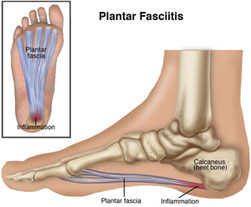Plantar fasciitis often presents as pain in the bottom of the heel. The plantar fascia is a band like structure that runs along the plantar (bottom) aspect on your foot. From your heel to your toes (refer to image). This structure can become painful due to local inflammation. This causes the plantar fascia to become thickened in size, which can be confirmed by ultrasound in most (but not all) cases. Tight calves are commonly associated with plantar fasciitis as it contributes to tightness along the band.

In most cases, it is painful in the mornings when getting out of bed or after rest. Plantar fasciitis can however, present in different ways. It can be most painful throughout the day when walking on your feet for extended periods of time or it may hurt most after extended periods of standing.
Heel pain however cannot be limited to plantar fasciitis. Although plantar fasciitis is the most common cause of heel pain. there are many other possible diagnoses which would alter treatment protocol. Some of these may be:
For this reason, it is not ideal to self diagnose according to your symptoms. it is best to visit your local podiatrist and have a full assessment conducted.
We utilise a range of treatment modalities to treat plantar fasciitis/fasciosis/fasciopathy depending on the symptoms and pathology specifics. Some treatment options may include but are not limited to:
The list goes on, however knowing how and what to do about it is not so simple. If you have any enquiries or would like to know more about what can be done to treat plantar fasciitis/faciopathy, you can contact us or simply make an online booking.
Heel pain however cannot be limited to plantar fasciitis. Although plantar fasciitis is the most common cause of heel pain. there are many other possible diagnoses which would alter treatment protocol. Some of these may be:
- Fat pad contusion/displacement
- Tarsal tunnel syndrome of tibial nerve (medial)
- Fracture/stress fractures of calcaneus
- Heel spur (enthesitis of the medical calcaneal tuberosity)
- Sciatica (entrapped between piriformis and obturator internus)
- Spring ligament tear (calc-nav)
- Giant cell tumor
- Bone marrow inflammation (osteomyelitis)
- Retro-calcaneal bursitis
- Achilles tendonitis/tendonosis
- Fibrosis of plantar fascia
For this reason, it is not ideal to self diagnose according to your symptoms. it is best to visit your local podiatrist and have a full assessment conducted.
We utilise a range of treatment modalities to treat plantar fasciitis/fasciosis/fasciopathy depending on the symptoms and pathology specifics. Some treatment options may include but are not limited to:
- Plantar fascial stretches
- Static stretches
- Dynamic stretches
- Eccentric loading
- Gastrocnemius/soleus deep tissue release/dry needling/PNF
- Shockwave therapy
- Custom orthotics or insoles
- Footwear
- Golf ball/iced water bottle rolling
- Ice/heat/compression
- Injection therapy
The list goes on, however knowing how and what to do about it is not so simple. If you have any enquiries or would like to know more about what can be done to treat plantar fasciitis/faciopathy, you can contact us or simply make an online booking.
By Ashraf Kodsy
Write something about yourself. No need to be fancy, just an overview.



 RSS Feed
RSS Feed
